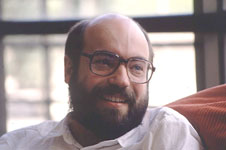
SRI Future Concepts Division is a research and development company in Palo Alto, California. It was founded in 1969 by Jacob E. "Jack" Goldman, chief scientist of Xerox Corporation, as a division of Xerox, tasked with creating computer technology-related products and hardware systems.
Context awareness refers, in information and communication technologies, to a capability to take into account the situation of entities, which may be users or devices, but are not limited to those. Location is only the most obvious element of this situation. Narrowly defined for mobile devices, context awareness does thus generalize location awareness. Whereas location may determine how certain processes around a contributing device operate, context may be applied more flexibly with mobile users, especially with users of smart phones. Context awareness originated as a term from ubiquitous computing or as so-called pervasive computing which sought to deal with linking changes in the environment with computer systems, which are otherwise static. The term has also been applied to business theory in relation to contextual application design and business process management issues.

A smart device is an electronic device, generally connected to other devices or networks via different wireless protocols that can operate to some extent interactively and autonomously. Several notable types of smart devices are smartphones, smart speakers, smart cars, smart thermostats, smart doorbells, smart locks, smart refrigerators, phablets and tablets, smartwatches, smart bands, smart keychains, smart glasses, and many others. The term can also refer to a device that exhibits some properties of ubiquitous computing, including—although not necessarily—machine learning.

A mobile device or handheld computer is a computer small enough to hold and operate in hand. Mobile devices are typically battery-powered and possess a flat-panel display and one or more built-in input devices, such as a touchscreen or keypad. Modern mobile devices often emphasize wireless networking, to both the Internet and to other devices in their vicinity, such as headsets or in-car entertainment systems, via Wi-Fi, Bluetooth, cellular networks, or near-field communication.

Mark D. Weiser was an American computer scientist and chief technology officer (CTO) at Xerox PARC. Weiser is widely considered to be the father of ubiquitous computing, a term he coined in 1988. Within Silicon Valley, Weiser was broadly viewed as a visionary and computer pioneer, and his ideas have influenced many of the world's leading computer scientists.
Calm technology or calm design is a type of information technology where the interaction between the technology and its user is designed to occur in the user's periphery rather than constantly at the center of attention. Information from the technology smoothly shifts to the user's attention when needed but otherwise stays calmly in the user's periphery. Mark Weiser and John Seely Brown describe calm technology as "that which informs but doesn't demand our focus or attention."

Ambient intelligence (AmI) refers to environments with electronic devices that are aware of and can recognize the presence of human beings and adapt accordingly. This concept encompasses various technologies in consumer electronics, telecommunications, and computing. Its primary purpose is to enhance user interactions through context-aware systems.

Smart environments link computers and other smart devices to everyday settings and tasks. Smart environments include smart homes, smart cities, and smart manufacturing.
Context-aware computing refers to a general class of mobile systems that can sense their physical environment, and adapt their behavior accordingly.
A pervasive game is one where the gaming experience is extended out into the real world, or where the fictional world in which the game takes place blends with the physical world. The "It's Alive" mobile games company described pervasive games as "games that surround you," while Montola, Stenros, and Waern's book Pervasive Games defines them as having "one or more salient features that expand the contractual magic circle of play spatially, temporally, or socially." The concept of a "magic circle" draws from the work of Johan Huizinga, who describes the boundaries of play.

Gregory Dominic Abowd is a computer scientist best known for his work in ubiquitous computing, software engineering, and technologies for autism. He currently serves as the Dean of the College of Engineering and Professor of Electrical and Computer Engineering at Northeastern University. Previously he was the J.Z. Liang Professor in the School of Interactive Computing at the Georgia Institute of Technology, where he joined the faculty in 1994.
Elizabeth D. "Beth" Mynatt is the Dean of the Khoury College of Computer Sciences at Northeastern University. She is former executive director of the Institute for People and Technology, director of the GVU Center at Georgia Tech, and Regents' and Distinguished Professor in the School of Interactive Computing, all at the Georgia Institute of Technology. In 2024, she was elected into the prestigious American Academy of Arts and Sciences.
The Telecooperation Office (TECO) is a research group at the Karlsruhe Institute of Technology in Karlsruhe, Germany. The research group is in the Institute of Telematics, and is attached to the chair for Pervasive Computing Systems, currently held by Michael Beigl.

Shwetak Naran Patel is an American computer scientist and entrepreneur best known for his work on developing novel sensing solutions and ubiquitous computing. He is the Washington Research Foundation Entrepreneurship Endowed Professor at the University of Washington in Computer Science & Engineering and Electrical Engineering, where he joined in 2008. His technology start-up company on energy sensing, Zensi, was acquired by Belkin International, Inc. in 2010. He was named a 2011 MacArthur Fellow. In 2016, He was elected as an ACM Fellow for contributions to sustainability sensing, low-power wireless sensing and mobile health and received Presidential Early Career Award for Scientists and Engineers (PECASE). He was named the recipient of the 2018 ACM Prize in Computing for contributions to creative and practical sensing systems for sustainability and health.
Hossein Rahnama is a Canadian computer scientist, specialising in ubiquitous and pervasive computing. His research explores artificial intelligence, mobile human-computer interaction, and the effective design of contextual services. In 2017, Rahnama was included in Caldwell Partners' list of "Canada’s Top 40 Under 40". In 2012, he was recognized by the MIT Technology Review as one of the world’s top innovators under the age of 35 for his research in context-aware computing. The Smithsonian named Rahnama as one of the top six innovators to watch in 2013. Rahnama has 30 publications and 10 patents in ubiquitous computing, serves on the board of Canadian Science Publishing, and was a Council Member of the National Sciences and Engineering Research Council (NSERC). Rahnama is also a visiting scholar at the Human Dynamics group at MIT Media Lab in Cambridge, MA. He has a PhD in Computer Science from Ryerson University. Rahmnama is an associate professor in Toronto Metropolitan University's RTA School of Media and Director of Research & Innovation at the university's Digital Media Zone.
Alice Jane Brush is an American computer scientist known for her research in human-computer interaction, ubiquitous computing and computer supported collaborative work (CSCW). She is particularly known for her research studying and building technology for homes as well as expertise conducting field studies of technology. She is the co-chair of CRA-W from 2014 to 2017.
Urban informatics refers to the study of people creating, applying and using information and communication technology and data in the context of cities and urban environments. It sits at the conjunction of urban science, geomatics, and informatics, with an ultimate goal of creating more smart and sustainable cities. Various definitions are available, some provided in the Definitions section.

Roy Want is a computer scientist born in London, United Kingdom in 1961. He received his PhD from Cambridge University (UK) in 1988 for his work on multimedia Distributed Systems; and is known for his work on indoor positioning, mobile and ubiquitous computing, automatic identification and the Internet of Things (IoT). He lives in Silicon Valley, California, and has authored or co-authored over 150 papers and articles on mobile systems, and holds 100+ patents. In 2011 he joined Google as a senior research scientist, and is in the Android group. Previous roles include senior principal engineer at Intel, and principal scientist at Xerox PARC...
Tanzeem Khalid Choudhury is the Roger and Joelle Burnell Professor in Integrated Health and Technology at Cornell Tech. Her research work is primarily in the area of mHealth.
Andrew Thomas Campbell is a computer scientist who works in the field of ubiquitous computing. He is best known for his research on mobile sensing, applied machine learning, mental health and human behavioral modeling.








